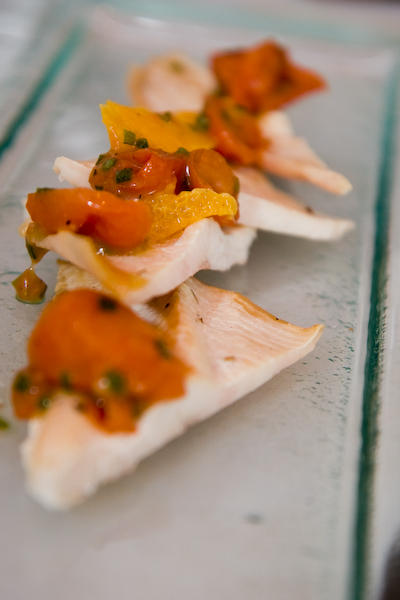เทคนิคและเคล็ดลับการถ่ายภาพอาหาร
Food Photography Techniques and Tips by Jonathan Pollack
ที่มา: digital-photography-school.com
Today food photographer Jonathan Pollackshares some wonderful food photography tips (and some positively mouth watering photos.Get more tips like this via email.
The food photography techniques in this post are ones that I use in photos I take for both a local food magazine and my wife’s cupcake blog. I’ve broken these techniques down into a few areas that give some ideas and suggestions to help you photograph and showcase your food.
Styling Your Food
I’ve never had the luxury of working with a food stylist; if you aren’t well-known, you will most likely take on this role yourself. While I lack the massive collection of props that a professional stylist would own, I do have at my disposal some place settings, backgrounds, and typically some degree of control over how food is presented. I don’t tend to use stand-ins or other tricks to get the results that I want, but remember that those are available if you need them. Whether I am at home or out shooting at restaurants, I am always challenged to use my on-hand supplies and creativity to create the right mood and draw the viewer in without distracting them. Getting started in styling food is not as difficult as you might think:
- Place solid or simple patterned papers (available at a scrapbooking store) as a background. Figure out what works and does not work in terms of contrast and similarity. Also, make sure that you have enough paper to completely cover the entire field of view.
- Experiment with incorporating serving pieces, whole place settings, napkins, placemats, and tablecloths. Set the table with silverware, drinks, and even candles to convey the right mood. If you’re budget-conscious, you can always find these items at thrift and resale stores, flea markets, and garage sales.
- If you have multiple food subjects available to you (like two dozen cupcakes from which to choose), use only the best examples. A blemish can easily ruin an entire photoshoot.
- Mist fruit, vegetables, and glassware with water to create condensation and make them look more appetizing. Shiny food appeals more than dull food, and anything you can do to make your food shine will make a more interesting photo.
- Incorporate elements from the food you’re shooting or place appropriate condiments in the frame. Slice cucumbers thinly and place them on top of yogurt soup to lend it some freshness. Accompany Thai food with small bowls of sugar, chili, fish sauce, and fresh limes. Some ideas will work, and some won’t.

Food Photography Composition
 My natural inclination when I started photographing food was to anchor myself somewhere, pick one zoom length for the entire shoot, center the food in the frame, and look down on it at a 45-degree angle - after all, this is how food appeared when I sat down to eat dinner. What I realized is that it didn’t make for interesting photos. Better shots play with angles and perspective:
My natural inclination when I started photographing food was to anchor myself somewhere, pick one zoom length for the entire shoot, center the food in the frame, and look down on it at a 45-degree angle - after all, this is how food appeared when I sat down to eat dinner. What I realized is that it didn’t make for interesting photos. Better shots play with angles and perspective:
- Zoom - with both your lens and your feet - to put the food in its place. Whether you are using a prime lens or a zoom lens, you can always get in close to magnify a detail of the food or loosen the shot up to show the food as a component of a larger meal.
- Rotate along all three axes. Some food looks best when looking directly down on it, while other food has an interesting side profile that can only be seen when shooting across the food at its level. Slightly tilting the camera clockwise or counterclockwise can add some interest to an otherwise dull photo. Take advantage of the low cost of experimentation since you’re shooting digitally.
- Use the rule of thirds. In general, the rule of thirds helps to easily give you compositionally strong photos, and this holds true not only for landscapes and action shots but for food as well. Practice following it to learn when you should treat it as a suggestion rather than a rule.
- Take advantage of the fact that your subjects won’t walk away. While a lot of food stylists say that you only have a short time to work with food after it’s served, that hasn’t been my experience (ice cream being the exception). I always feel that I can walk around, zoom, hover, and poke and prod to get the shots I need.

Remember Established Photography Techniques
You should apply to food photography all of the other general photographic principles that you read about or already know. Aim for soft shadows, good exposure, and good color rendering. Experiment with your focal point and available apertures. Pay close attention to white balance and color casts or consider shooting RAW. Use a tripod if you aren’t going to be stable enough to keep your food from shaking. Finally, don’t be afraid to add some artistic flair to your images through creative post-processing.
Tags:
Creative Citizen NEWS
© 2009-2025 PORTFOLIOS*NET by CreativeMOVE.
Powered by
![]()